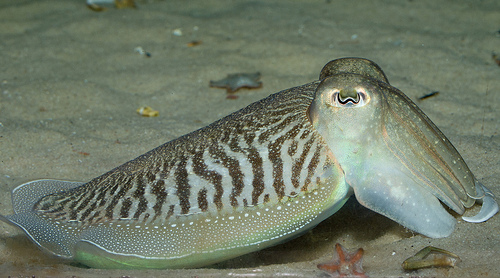Cuttlefish are not fish!
- Cuttlefish are aquatic animals of the mollusc type, and they are cephalopods that feature a pronounced head and a total of ten tentacles, eight of which are short.
- Cuttlefish are typically 15 to 50 centimetres (6 to 20 inches) in length, plus the length of the tentacles, and weigh 3 to 10.5 kilograms (6.6 to 23 pounds).
- There are approximately 120 species of cuttlefish, and they are from the order with the scientific name Sepiida, that contains five families, and they are related to octopus and squid.
- The diet of cuttlefish consists primarily of fish, crabs, molluscs, shrimp and worms, among others.
- Due to their ability to change body colour for camouflage purposes or other reasons, as well as the differences between species, cuttlefish can come in a variety of colours, including red, pink, yellow, green, brown, white and blue.
Cuttlefish
Image courtesy of William Warby/Flickr
- Inside a cuttlefish there is distinct aragonite porous shell, known as a ‘cuttlebone’ that is often found on the beach and fed to pet birds as a source of calcium, and the blood of the animal is coloured a greenish-blue and pumped around by three hearts.
- Poison that can be lethal and is used to paralyse its prey, is produced by a cuttlefish in its mouth, and the animal captures its prey by two long tentacles that propel out from its body and later retract.
- To protect itself from predators such as sharks and large fish, cuttlefish may use camouflage or produce ink to obscure the other animal’s vision.
- To find a mate, a male cuttlefish will change its skin colour for appeal, while females die after laying approximately 200 eggs; and the animal has an average lifespan of one to three years.
- Cuttlefish can be found in most oceans around the world, however they do not live around North or South America; and some cultures enjoy the animal as food, and they are commonly dried and shredded and eaten as a snack.
Bibliography:
Cuttlefish, 2013, A-Z Animals, http://a-z-animals.com/animals/cuttlefish/
Cuttlefish, 2015, Net Industries, http://science.jrank.org/pages/1918/Cuttlefish.html
Cuttlefish, 2015, Wikipedia, http://en.wikipedia.org/wiki/Cuttlefish






